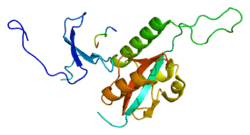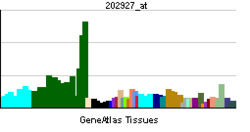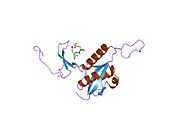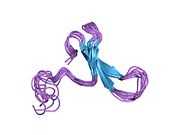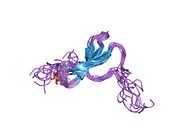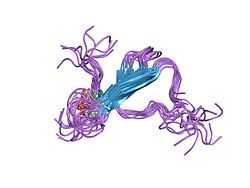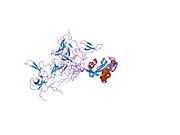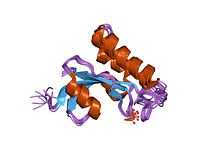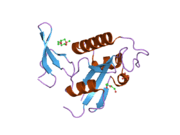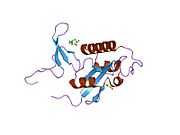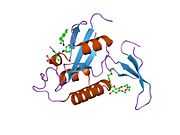PIN1
Peptidyl-prolyl cis-trans isomerase NIMA-interacting 1 is an enzyme that in humans is encoded by the PIN1 gene.[1][2] (Not to be confused with PIN1 (Pin-formed 1), an auxin transporter in Arabidopsis thaliana.)
Pin 1, or peptidyl-prolyl cis/trans isomerase (PPIase), isomerizes only phospho-Serine/Threonine-Proline motifs. The enzyme binds to a subset of proteins and thus plays a role as a post phosphorylation control in regulating protein function. Studies have shown that the deregulation of Pin1 may play a pivotal role in various diseases. Notably, the up-regulation of Pin1 may be implicated in certain cancers, and the down-regulation of Pin1 may be implicated in Alzheimer's disease. Inhibitors of Pin1 may have therapeutic implications for cancer and immune disorders.
Discovery and characterization
The gene encoding Pin1 was identified in 1996 as a result of a genetic/biochemical screen for proteins involved in mitotic regulation. It was found to be essential for cell division in some organisms. By 1999, however, it was apparent that Pin1 knockout mice had a surprisingly mild phenotype, indicating that the enzyme was not required for cell division per se. Further studies later found that loss of Pin1 in mice displays are not only neuronal degenerative phenotypes but also several abnormalities, similar to those of cyclin D1-null mice, suggesting the conformation changes mediated by Pin1 may be crucial for cell normal function.
Activation of Pin1
Phosphorylation of Ser/Thr-Pro motifs in substrates is required for recognition by Pin1. Pin is a small protein at 18 kDa and does not have a nuclear localization or export signal. Substrate interactions and a WW domain determine subcellular distribution. Expression is induced by growth signals from E2F transcription factors. Expression levels fluctuate in normal, but not in cancerous cells. Expression is often associated with cell proliferation. Postranslational modifications such as phosphorylation on Ser16 inhibit the ability of Pin1 to bind substrate, and this inhibitory process may be altered during oncogenesis. It is hypothesized, but not proven, that Pin1 might also be regulated by proteolytic pathways.
Biological function
Pin1 activity regulates the outcome of proline-directed kinase (e.g. MAPK, CDK or GSK3) signalling and consequently regulates cell proliferation (in part through control of cyclin D1 levels and stability) and cell survival. The precise effects of Pin1 depend upon the system: Pin1 accelerates dephosphorylation of Cdc25 and Tau, but protects phosphorylated cyclin D from ubiquitination and proteolysis. Recent data also implicate Pin1 as playing an important role in immune responses, at least in part by increasing the stability of cytokine mRNAs by influencing the protein complexes to which they bind. A recent review by Kun Ping Lu attempts to provide a unifying framework for understanding Pin1 function by hypothesising that Pin1 acts as a molecular timer.[3]
Interactions
PIN1 has been shown to interact with CSNK2A2,[4] Casein kinase 2, alpha 1,[4] Wee1-like protein kinase,[5] FOXO4,[6] CDC25C,[5][7][8] CDC27,[5][8] MYT1,[9] PLK1,[5][8] MPHOSPH1,[10] DAB2,[11] P53,[12][13] PKMYT1,[5] C-jun,[14] SUPT5H,[15] Mothers against decapentaplegic homolog 3[16] and Mothers against decapentaplegic homolog 2.[16] PIN1 has also been shown to interact with endothelial nitric oxide synthase (eNOS).[17]
References
- ↑ Lu KP, Hanes SD, Hunter T (May 1996). "A human peptidyl-prolyl isomerase essential for regulation of mitosis". Nature 380 (6574): 544–7. doi:10.1038/380544a0. PMID 8606777.
- ↑ "Entrez Gene: PIN1 Protein (peptidylprolyl cis/trans isomerase) NIMA-interacting 1".
- ↑ Lu, KP; Finn G; Lee TH; Nicholson LK (Oct 2007). "Prolyl cis-trans isomerization as a molecular timer". Nat. Chem. Biol. (United States) 3 (10): 619–29. doi:10.1038/nchembio.2007.35. ISSN 1552-4469. PMID 17876319.
- ↑ 4.0 4.1 Messenger, Moira M; Saulnier Ronald B; Gilchrist Andrew D; Diamond Phaedra; Gorbsky Gary J; Litchfield David W (June 2002). "Interactions between protein kinase CK2 and Pin1. Evidence for phosphorylation-dependent interactions". J. Biol. Chem. 277 (25): 23054–64. doi:10.1074/jbc.M200111200. ISSN 0021-9258. PMID 11940573.
- ↑ 5.0 5.1 5.2 5.3 5.4 Shen, M; Stukenberg P T; Kirschner M W; Lu K P (March 1998). "The essential mitotic peptidyl-prolyl isomerase Pin1 binds and regulates mitosis-specific phosphoproteins". Genes Dev. 12 (5): 706–20. doi:10.1101/gad.12.5.706. ISSN 0890-9369. PMC 316589. PMID 9499405.
- ↑ Brenkman, Arjan B; de Keizer Peter L J, van den Broek Niels J F, van der Groep Petra, van Diest Paul J, van der Horst Armando, Smits Alida M M, Burgering Boudewijn M T (September 2008). "The peptidyl-isomerase Pin1 regulates p27kip1 expression through inhibition of Forkhead box O tumor suppressors". Cancer Res. 68 (18): 7597–605. doi:10.1158/0008-5472.CAN-08-1059. PMID 18794148.
- ↑ Goldstrohm, AC; Albrecht TR; Suñé C; Bedford MT; Garcia-Blanco MA (November 2001). "The transcription elongation factor CA150 interacts with RNA polymerase II and the pre-mRNA splicing factor SF1". Mol. Cell. Biol. (United States) 21 (22): 7617–28. doi:10.1128/MCB.21.22.7617-7628.2001. ISSN 0270-7306. PMC 99933. PMID 11604498.
- ↑ 8.0 8.1 8.2 Lu, PJ; Zhou X Z; Shen M; Lu K P (February 1999). "Function of WW domains as phosphoserine- or phosphothreonine-binding modules". Science 283 (5406): 1325–8. doi:10.1126/science.283.5406.1325. ISSN 0036-8075. PMID 10037602.
- ↑ Wells, NJ; Watanabe N; Tokusumi T; Jiang W; Verdecia M A; Hunter T (October 1999). "The C-terminal domain of the Cdc2 inhibitory kinase Myt1 interacts with Cdc2 complexes and is required for inhibition of G(2)/M progression". J. Cell. Sci. 112: 3361–71. ISSN 0021-9533. PMID 10504341.
- ↑ Kamimoto, T; Zama T; Aoki R; Muro Y; Hagiwara M (October 2001). "Identification of a novel kinesin-related protein, KRMP1, as a target for mitotic peptidyl-prolyl isomerase Pin1". J. Biol. Chem. 276 (40): 37520–8. doi:10.1074/jbc.M106207200. ISSN 0021-9258. PMID 11470801.
- ↑ He, Junqi; Xu Jianguo; Xu Xiang-Xi; Hall Randy A (July 2003). "Cell cycle-dependent phosphorylation of Disabled-2 by cdc2". Oncogene 22 (29): 4524–30. doi:10.1038/sj.onc.1206767. ISSN 0950-9232. PMID 12881709.
- ↑ Wulf, Gerburg M; Liou Yih-Cherng; Ryo Akihide; Lee Sam W; Lu Kun Ping (December 2002). "Role of Pin1 in the regulation of p53 stability and p21 transactivation, and cell cycle checkpoints in response to DNA damage". J. Biol. Chem. (United States) 277 (50): 47976–9. doi:10.1074/jbc.C200538200. ISSN 0021-9258. PMID 12388558.
- ↑ Zacchi, Paola; Gostissa Monica; Uchida Takafumi; Salvagno Clio; Avolio Fabio; Volinia Stefano; Ronai Ze'ev; Blandino Giovanni; Schneider Claudio; Del Sal Giannino (October 2002). "The prolyl isomerase Pin1 reveals a mechanism to control p53 functions after genotoxic insults". Nature 419 (6909): 853–7. doi:10.1038/nature01120. ISSN 0028-0836. PMID 12397362.
- ↑ Wulf, G M; Ryo A; Wulf G G; Lee S W; Niu T; Petkova V; Lu K P (July 2001). "Pin1 is overexpressed in breast cancer and cooperates with Ras signaling in increasing the transcriptional activity of c-Jun towards cyclin D1". EMBO J. (England) 20 (13): 3459–72. doi:10.1093/emboj/20.13.3459. ISSN 0261-4189. PMC 125530. PMID 11432833.
- ↑ Lavoie, S B; Albert A L; Handa H; Vincent M; Bensaude O (September 2001). "The peptidyl-prolyl isomerase Pin1 interacts with hSpt5 phosphorylated by Cdk9". J. Mol. Biol. 312 (4): 675–85. doi:10.1006/jmbi.2001.4991. ISSN 0022-2836. PMID 11575923.
- ↑ 16.0 16.1 Nakano, Ayako; Koinuma Daizo, Miyazawa Keiji, Uchida Takafumi, Saitoh Masao, Kawabata Masahiro, Hanai Jun-ichi, Akiyama Hirotada, Abe Masahiro, Miyazono Kohei, Matsumoto Toshio, Imamura Takeshi (March 2009). "Pin1 down-regulates transforming growth factor-beta (TGF-beta) signaling by inducing degradation of Smad proteins". J. Biol. Chem. 284 (10): 6109–15. doi:10.1074/jbc.M804659200. ISSN 0021-9258. PMID 19122240.
- ↑ Ruan L, Torres CM, Qian J, Chen F, Mintz JD, Stepp DW, Fulton D, Venema RC (2011). "Pin1 Prolyl Isomerase Regulates Endothelial Nitric Oxide Synthase". Arterioscler Thromb Vasc Biol 31 (2): 392–398. doi:10.1161/ATVBAHA.110.213181. PMC 3075952. PMID 21051667.
Further reading
- Lu KP, Liou YC, Zhou XZ (2002). "Pinning down proline-directed phosphorylation signaling.". Trends Cell Biol. 12 (4): 164–72. doi:10.1016/S0962-8924(02)02253-5. PMID 11978535.
- Wulf G, Finn G, Suizu F, Lu KP (2005). "Phosphorylation-specific prolyl isomerization: is there an underlying theme?". Nat. Cell Biol. 7 (5): 435–41. doi:10.1038/ncb0505-435. PMID 15867923.
- Etzkorn FA (2007). "Pin1 flips Alzheimer's switch.". ACS Chem. Biol. 1 (4): 214–6. doi:10.1021/cb600171g. PMID 17163675.
- Balastik M, Lim J, Pastorino L, Lu KP (2007). "Pin1 in Alzheimer's disease: multiple substrates, one regulatory mechanism?". Biochim. Biophys. Acta 1772 (4): 422–9. doi:10.1016/j.bbadis.2007.01.006. PMC 1868500. PMID 17317113.
- Maleszka R, Hanes SD, Hackett RL et al. (1996). "The Drosophila melanogaster dodo (dod) gene, conserved in humans, is functionally interchangeable with the ESS1 cell division gene of Saccharomyces cerevisiae.". Proc. Natl. Acad. Sci. U.S.A. 93 (1): 447–51. doi:10.1073/pnas.93.1.447. PMC 40255. PMID 8552658.
- Ranganathan R, Lu KP, Hunter T, Noel JP (1997). "Structural and functional analysis of the mitotic rotamase Pin1 suggests substrate recognition is phosphorylation dependent.". Cell 89 (6): 875–86. doi:10.1016/S0092-8674(00)80273-1. PMID 9200606.
- Campbell HD, Webb GC, Fountain S, Young IG (1997). "The human PIN1 peptidyl-prolyl cis/trans isomerase gene maps to human chromosome 19p13 and the closely related PIN1L gene to 1p31.". Genomics 44 (2): 157–62. doi:10.1006/geno.1997.4854. PMID 9299231.
- Crenshaw DG, Yang J, Means AR, Kornbluth S (1998). "The mitotic peptidyl-prolyl isomerase, Pin1, interacts with Cdc25 and Plx1.". EMBO J. 17 (5): 1315–27. doi:10.1093/emboj/17.5.1315. PMC 1170480. PMID 9482729.
- Shen M, Stukenberg PT, Kirschner MW, Lu KP (1998). "The essential mitotic peptidyl-prolyl isomerase Pin1 binds and regulates mitosis-specific phosphoproteins.". Genes Dev. 12 (5): 706–20. doi:10.1101/gad.12.5.706. PMC 316589. PMID 9499405.
- Lu PJ, Zhou XZ, Shen M, Lu KP (1999). "Function of WW domains as phosphoserine- or phosphothreonine-binding modules.". Science 283 (5406): 1325–8. doi:10.1126/science.283.5406.1325. PMID 10037602.
- Lu PJ, Wulf G, Zhou XZ et al. (1999). "The prolyl isomerase Pin1 restores the function of Alzheimer-associated phosphorylated tau protein.". Nature 399 (6738): 784–8. doi:10.1038/21650. PMID 10391244.
- Albert A, Lavoie S, Vincent M (1999). "A hyperphosphorylated form of RNA polymerase II is the major interphase antigen of the phosphoprotein antibody MPM-2 and interacts with the peptidyl-prolyl isomerase Pin1.". J. Cell. Sci. 112. ( Pt 15): 2493–500. PMID 10393805.
- Wells NJ, Watanabe N, Tokusumi T et al. (1999). "The C-terminal domain of the Cdc2 inhibitory kinase Myt1 interacts with Cdc2 complexes and is required for inhibition of G(2)/M progression.". J. Cell. Sci. 112. ( Pt 19): 3361–71. PMID 10504341.
- Gerez L, Mohrmann K, van Raak M et al. (2000). "Accumulation of rab4GTP in the cytoplasm and association with the peptidyl-prolyl isomerase pin1 during mitosis.". Mol. Biol. Cell 11 (7): 2201–11. doi:10.1091/mbc.11.7.2201. PMC 14913. PMID 10888662.
- Verdecia MA, Bowman ME, Lu KP et al. (2000). "Structural basis for phosphoserine-proline recognition by group IV WW domains.". Nat. Struct. Biol. 7 (8): 639–43. doi:10.1038/77929. PMID 10932246.
- Rippmann JF, Hobbie S, Daiber C et al. (2000). "Phosphorylation-dependent proline isomerization catalyzed by Pin1 is essential for tumor cell survival and entry into mitosis.". Cell Growth Differ. 11 (7): 409–16. PMID 10939594.
- Liu W, Youn HD, Zhou XZ et al. (2001). "Binding and regulation of the transcription factor NFAT by the peptidyl prolyl cis-trans isomerase Pin1.". FEBS Lett. 496 (2-3): 105–8. doi:10.1016/S0014-5793(01)02411-5. PMID 11356192.
- Wulf GM, Ryo A, Wulf GG et al. (2001). "Pin1 is overexpressed in breast cancer and cooperates with Ras signaling in increasing the transcriptional activity of c-Jun towards cyclin D1.". EMBO J. 20 (13): 3459–72. doi:10.1093/emboj/20.13.3459. PMC 125530. PMID 11432833.
- Kamimoto T, Zama T, Aoki R et al. (2001). "Identification of a novel kinesin-related protein, KRMP1, as a target for mitotic peptidyl-prolyl isomerase Pin1.". J. Biol. Chem. 276 (40): 37520–8. doi:10.1074/jbc.M106207200. PMID 11470801.
| |||||||||||||||||||||||||||
